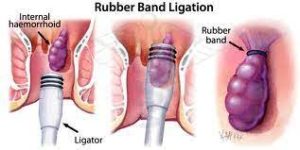 Rubber band ligation refers to a small band is applied to the base of the hemorrhoid, stopping the blood supply to the hemorrhoidal mass.
Rubber band ligation refers to a small band is applied to the base of the hemorrhoid, stopping the blood supply to the hemorrhoidal mass.
The hemorrhoid shrinks and fibroses within a few days with shriveled hemorrhoidal tissue.
The banding falls off during normal bowel movements, likely without the patient noticing.
Rubber band ligation involves a much lower risk of pain than surgical treatments of hemorrhoids, as well as a shorter recovery period.
When done with the CRH O’Regan System, it is also associated with a recurrence rate of 5% at 2 years.
The procedure is typically performed by gastroenterologists, colorectal surgeons, and general surgeons.
The patient is generally placed on a proctology table in the kneeling position or, less commonly, on the left side on an exam table, with knees drawn up as in the fetal position.
The hemorrhoid is grasped by forceps and maneuvered into the cylindrical opening of the ligator.
The ligator is then pushed up against the base of the hemorrhoid, and the rubber band is applied.
Suction is used rather than forceps to draw tissue into the instrument so the rubber band can be deployed.
The CRH O’Regan ligation system also eliminates the use of forceps.
Three banding sessions are typically required at 2 week intervals for a complete treatment.
More bands can be applied if the patient is under general anesthetic, although the recovery time may be prolonged and more painful.
Possible complications from rubber band ligation include:
Pain
Bleeding
Infection and pelvic sepsis
Thrombosed hemorrhoids
Non-healing ulcer
Patients may experience some bleeding, especially after bowel movements, up to 2 weeks after the banding.
Acetaminophen can be taken for any discomfort the patient may feel.
Ibuprofen should be avoided.
A warm bath for about 10 minutes, 2-3 times a day, may help.
A stool softener is recommended once a day for about 3 days.
Patient should avoid straining to have a bowel movement.
Avoiding constipation with a fiber supplement should be taken daily while increasing water intake to 8 glasses daily.
